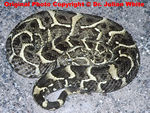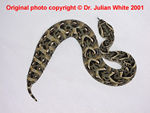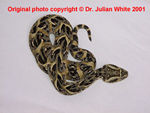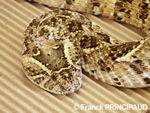|
Bitis arietans
|
![Bitis arietans ( Puff Adder ) [ Original photo copyright © Dr Julian White ]](images/snakes/SNP02001.jpg)
|
|
Family: Viperidae
|
|
Subfamily: Viperinae
|
|
Genus: Bitis
|
|
Species: arietans
|
|
Subspecies: arietans , somalica
|
Common Names
Puff Adder , Common Puff Adder , African Puff Adder ( B. a. arietans ) , Somali Puff Adder ( B. a. somalica )
|
Local Names
Gewone Pofadder , Aipomiro , Akipom , Asigirikolongo , Boma , Bulabundo , Chikorviri , Chiva , Coichodo , El Nawama , Essalambwa , Ibululu , Impiri , Ki-iri , Monaroub , Monnarub , Mpomo , Moma , Mpiri , Mpili , Olwero , Pilipili , Uyu , Kassa , M'vumbi , Dolalat , Tarsha , Nawama
|
Region
Middle East + North Africa + Sub-Saharan Africa
|
Countries
Angola, Benin, Botswana, Burkina Faso, Burundi, Cameroon, Central African Republic, Chad, Democratic Republic of Congo, Cote d'Ivoire ( Ivory Coast ), Djibouti, Eritrea, Ethiopia, Gambia, Ghana, Guinea, Guinea-Bissau, Kenya, Lesotho, Malawi, Mali, Morocco, Mozambique, Namibia, Niger, Nigeria, Oman, Rwanda, Saudi Arabia, Senegal, Sierra Leone, South Africa, Sudan, Swaziland, Tanzania, Togo, Uganda, Yemen, Zambia, Zimbabwe, West Sahara, Somalia
|
|

|
|
|
|
Taxonomy and Biology
|
|
Adult Length: 0.70 m
|
General Shape
Large in length, thick, extremely stout and heavy bodied snake with a short ( males ) to very short ( females ) tail. Can grow to a maximum of about 1.91 metres ( with a girth of 38 cm ). Saudi Arabian specimens are much smaller, rarely exceeding 0.80 metres. Unusually, the largest specimens are found in semi desert and dry savanna regions. Head is broad, flattened, lanceolate and very distinct from narrow neck. Head is covered with small, keeled, imbricate scales. Snout is short and canthus is distinct. Nostrils are large and face more directly upward than in any other African viper. Eyes are medium in size with vertically elliptical pupils. Dorsal scales are heavily keeled with apical pits ( outer scale row is smooth or feebly keeled ).
|
Habitat
Very adaptable to a wide range of habitats ( including savanna, scrub and semi-desert ) up to about 3500 metres elevation. Only absent from true desert, tropical rainforest and very high montane grassland and peaks.
|
Habits
Terrestrial, mainly nocturnal and very sluggish snake. Emerges at dusk and remains hidden in cover ( effective camouflage ) ready to ambush prey. If disturbed it inflates its body with air and exhaling in loud hisses or puffs ( hence its common name ) and will adopt a striking posture with the anterior body held in a taut S shape. At the same time though, it edges itself backward into cover. It will strike readily and swiftly if cornered or provoked. Often swims, but on land moves with a caterpillar like motion leaving a straight track in sand or loose soil.
|
Prey
Feeds on a wide variety of prey, including hares, hedgehogs, grasshoppers and cockroaches but most often on rodents, small mammals, lizards and birds, occasionally other snakes. An opportunistic feeder. Young feed mainly on toads and frogs.
|
|
|
|
Venom
|
Average Venom Qty
130 to 200 mg ( dry weight ), U.S. Dept. Navy (1968) ( Ref : R000914 ).
160 to 200 mg ( dry weight ), Minton (1974) ( Ref : R000504 ).
|
General: Venom Neurotoxins
Not present
|
General: Venom Myotoxins
Not present
|
General: Venom Procoagulants
Possibly present
|
General: Venom Anticoagulants
Possibly present
|
General: Venom Haemorrhagins
Present but not defined
|
General: Venom Nephrotoxins
Possibly present
|
General: Venom Cardiotoxins
Not present
|
General: Venom Necrotoxins
Present but not defined
|
General: Venom Other
Unknown
|
|
|
|
Clinical Effects
|
General: Dangerousness
Severe envenoming possible, potentially lethal
|
|
General: Rate of Envenoming: 60-80%
|
|
General: Untreated Lethality Rate: Unknown
|
General: Local Effects
Marked local effects; pain, severe swelling, bruising, blistering
|
General: Local Necrosis
Very common, moderate to severe
|
General: General Systemic Effects
Variable non-specific effects which may include headache, nausea, vomiting, abdominal pain, diarrhoea, dizziness, collapse or convulsions
|
General: Neurotoxic Paralysis
Unlikely to occur
|
General: Myotoxicity
Not likely to occur
|
General: Coagulopathy & Haemorrhages
Common, moderate to severe coagulopathy + haemorrhagins causing extensive bleeding
|
General: Renal Damage
Rare, usually secondary effect
|
General: Cardiotoxicity
Common, cardiotoxicity is major clinical effect
|
General: Other
Shock secondary to fluid shifts due to local tissue injury is likely in severe cases
|
|
|
|
First Aid
|
|
Description: First aid for bites by Viperid snakes likely to cause significant local injury at the bite site (see listing in Comments section).
|
Details
1. After ensuring the patient and onlookers have moved out of range of further strikes by the snake, the bitten person should be reassured and persuaded to lie down and remain still. Many will be terrified, fearing sudden death and, in this mood, they may behave irrationally or even hysterically. The basis for reassurance is the fact that many venomous bites do not result in envenoming, the relatively slow progression to severe envenoming (hours following elapid bites, days following viper bites) and the effectiveness of modern medical treatment.
2. The bite wound should not be tampered with in any way. Wiping it once with a damp cloth to remove surface venom is unlikely to do much harm (or good) but the wound must not be massaged.
3. All rings or other jewellery on the bitten limb, especially on fingers, should be removed, as they may act as tourniquets if oedema develops.
4. The bitten limb should be immobilised as effectively as possible using an extemporised splint or sling; if available, crepe bandaging of the splinted limb is an effective form of immobilisation.
5. If there is any impairment of vital functions, such as problems with respiration, airway, circulation, heart function, these must be supported as a priority. In particular, for bites causing flaccid paralysis, including respiratory paralysis, both airway and respiration may be impaired, requiring urgent and prolonged treatment, which may include the mouth to mask (mouth to mouth) technique of expired air transfer. Seek urgent medical attention.
6. Do not use Tourniquets, cut, suck or scarify the wound or apply chemicals or electric shock.
7. Avoid peroral intake, absolutely no alcohol. No sedatives outside hospital. If there will be considerable delay before reaching medical aid, measured in several hours to days, then give clear fluids by mouth to prevent dehydration.
8. If the offending snake has been killed it should be brought with the patient for identification (only relevant in areas where there are more than one naturally occurring venomous snake species), but be careful to avoid touching the head, as even a dead snake can envenom. No attempt should be made to pursue the snake into the undergrowth as this will risk further bites.
9. The snakebite victim should be transported as quickly and as passively as possible to the nearest place where they can be seen by a medically-trained person (health station, dispensary, clinic or hospital). The bitten limb must not be exercised as muscular contraction will promote systemic absorption of venom. If no motor vehicle or boat is available, the patient can be carried on a stretcher or hurdle, on the pillion or crossbar of a bicycle or on someone's back.
10. Most traditional, and many of the more recently fashionable, first aid measures are useless and potentially dangerous. These include local cauterization, incision, excision, amputation, suction by mouth, vacuum pump or syringe, combined incision and suction ("venom-ex" apparatus), injection or instillation of compounds such as potassium permanganate, phenol (carbolic soap) and trypsin, application of electric shocks or ice (cryotherapy), use of traditional herbal, folk and other remedies including the ingestion of emetic plant products and parts of the snake, multiple incisions, tattooing and so on.
|
|
|
|
Treatment
|
Treatment Summary
Puff adder bites are likely to cause severe local & systemic envenoming rapidly, requiring urgent assessment & treatment. Fluid shift & shock may occur. Urgent fluid load, good wound care and antivenom are required. While compartment syndrome can occur, it must be confirmed by pressure measurement before considering fasciotomy. Beware any surgical intervention while venom haemorrhagins are active.
|
Key Diagnostic Features
Local swelling, blistering, necrosis + coagulopathy, bleeding
|
General Approach to Management
All cases should be treated as urgent & potentially lethal. Rapid assessment & commencement of treatment including appropriate antivenom (if indicated & available) is mandatory. Admit all cases.
|
Antivenom Therapy
Antivenom is the key treatment for systemic envenoming. Multiple doses may be required.
|
| 1. Antivenom Code: SAfSAI03
|
|
Antivenom Name: SAIMR Polyvalent Antivenom
|
|
Manufacturer: South African Vaccine Producers (Pty) Ltd
|
|
Phone: +27 11 386-6000; +27 11 386-6078
|
Address: Postal address
PO Box 28999
Sandringham 2131
Gauteng Province
Physical address
1 Modderfontein Road
Sandringham, Johannesburg
|
|
Country: South Africa
|
| 2. Antivenom Code: SAfSAIBK
|
|
Antivenom Name: SAIMR Snakebite Kit
|
|
Manufacturer: South African Vaccine Producers (Pty) Ltd
|
|
Phone: +27 11 386-6000; +27 11 386-6078
|
Address: Postal address
PO Box 28999
Sandringham 2131
Gauteng Province
Physical address
1 Modderfontein Road
Sandringham, Johannesburg
|
|
Country: South Africa
|
| 3. Antivenom Code: SAfAVC02
|
|
Antivenom Name: Polyvalent Snake Antivenom
|
|
Manufacturer: National Antivenom and Vaccine Production Centre
|
|
Phone: ++966-1-252-0088 ext 45626, 45637.
|
Address: P.O. Box 22490
Riyadh 11426
|
|
Country: Saudi Arabia
|
| 4. Antivenom Code: SAfIBM01
|
|
Antivenom Name: Antivipmyn Africa
|
|
Manufacturer: Instituto Bioclon
|
|
Phone: ++56-65-41-11
|
Address: Calzada de Tlalpan No. 4687
Toriello Guerra
C.P. 14050
Mexico, D.F.,
|
|
Country: Mexico
|
| 5. Antivenom Code: SAfICP07
|
|
Antivenom Name: Pan-African antivenom (EchiTAb-Plus-ICP)
|
|
Manufacturer: Instituto Clodomiro Picado
|
|
Phone: ++506-2511-7888
|
Address: Contiguo a la plaza de deportes,
Dulce Nombre de Coronado.
San José
Costa Rica
|
|
Country: Costa Rica
|
| 6. Antivenom Code: SAfVAC02
|
|
Antivenom Name: Polyvalent Snake Venom Antiserum
|
|
Manufacturer: VACSERA
|
|
Phone: (+20 2) 3761-1111
|
|
Address: 51 Wezaret El Zeraa St., Agouza, Giza, 22311
|
|
Country: Egypt
|
| 7. Antivenom Code: SAfSPF02
|
|
Antivenom Name: FAV-Afrique
|
|
Manufacturer: Sanofi-Pasteur
|
|
Phone: +33 (0)4 37 37 01 00
|
|
Address: 2, Avenue Pont Pasteur, CEDEX 07, Lyon 69367
|
|
Country: France
|
| 8. Antivenom Code: SAfSPF03
|
|
Antivenom Name: Favirept
|
|
Manufacturer: Sanofi-Pasteur
|
|
Phone: +33 (0)4 37 37 01 00
|
|
Address: 2, Avenue Pont Pasteur, CEDEX 07, Lyon 69367
|
|
Country: France
|
|
|
|
Images
|

|

|

|

|
|
|
|
Bitis arietans ( Puff Adder ) [ Original photo copyright © Dr Julian White ]
|
Bitis arietans ( Puff Adder ) [ Original photo copyright © Dr Julian White ]
|
Bitis arietans ( Puff Adder ) [ Original photo copyright © Dr Julian White ]
|
Bitis arietans ( Puff Adder ) [ Original photo copyright © Franck Principaud]
|
|
|
|
|
|



